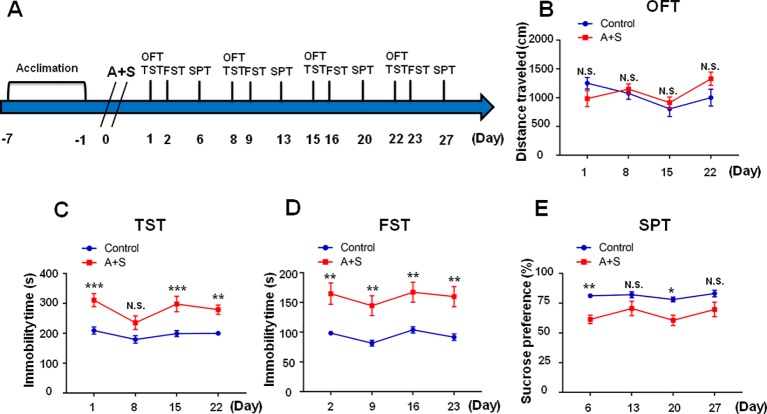Figure 1.
Effects of anesthesia and surgery on depression-like symptoms in OFT, TST, FST, and SPT. The results of OFT, TST, FST, and SPT in control and A+S mice. (A) The schedule of the experiment. A+S was performed on day 0 after acclimation. OFT and TST were measured on day 1, 8, 15, and 22 after A+S, respectively. FST was performed on day 2, 9, 16, and 23 after A+S, respectively. SPT was performed on day 6, 13, 20, and 27 after A+S, respectively. (B) OFT [time: F (3, 54) = 2.679, P > 0.05; group: F (1, 18) = 0.3479, P = 0.5627; interaction: F (3, 54) = 1.887, P = 0.1427] in control and A+S groups. (C) TST [time: F (3, 54) = 3.151, P = 0.0322; group: F (1, 18) = 65.29, P < 0.001; interaction: F (3, 54) = 0.6903, P = 0.5619] in control and A+S groups. (D) FST [time: F (3, 54) = 1.343, P = 0.27; group: F (1, 18) = 41.97, P < 0.001; interaction: F (3, 54) = 0.02221, P = 0.9955] was measured in control and A+S groups. (E) SPT [time: F (3, 54) = 1.76, P = 0.1659; group: F (1,18) = 23.76, P < 0.001; interaction: F (3, 54) = 0.4846, P = 0.6944] was measured in control and A+S groups. Data are shown as mean ± SEM (n = 10). *P < 0.05, **P < 0.01, ***P < 0.001. A+S, anesthesia and surgery; FST, forced swimming test; N.S., not significant; OFT, open field test, SPT, sucrose preference test; TST, tail suspension test.

